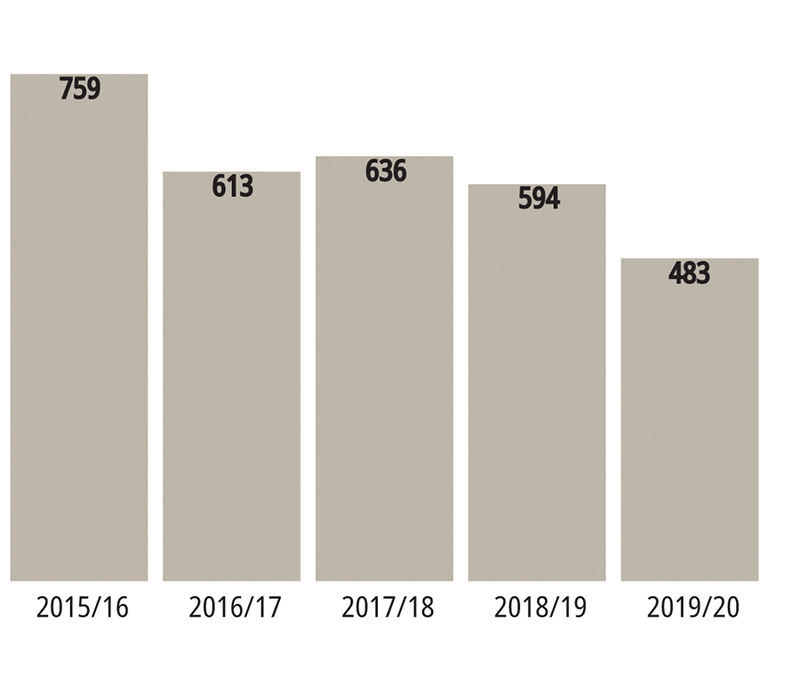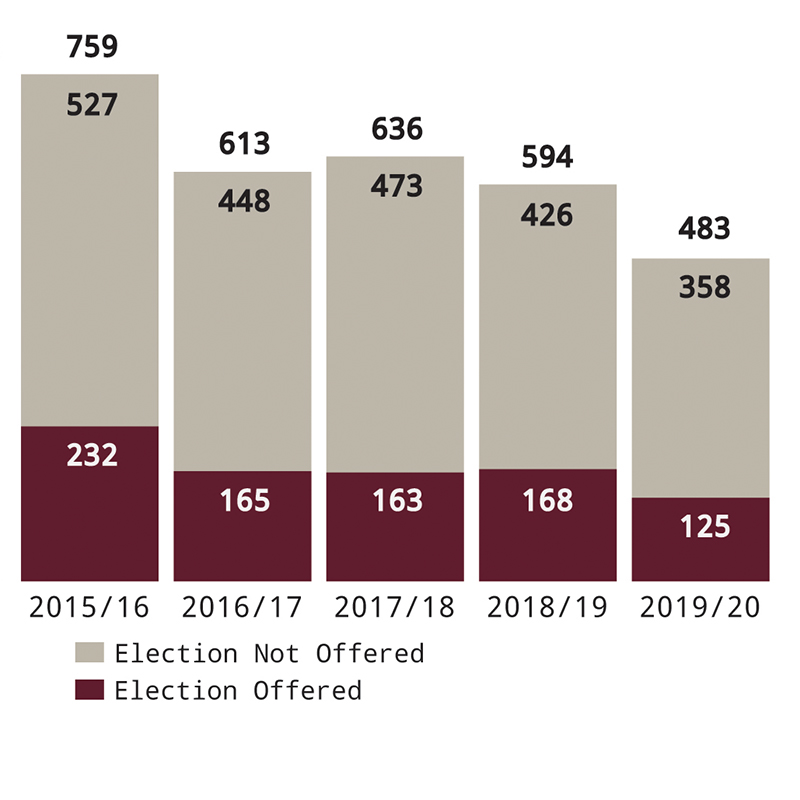Chapter Two — The Canadian Military Justice System: Structure and Statistics
Canada’s Military Justice System
Canada’s military justice system is a separate and parallel system of justice that forms an integral part of the Canadian legal mosaic. It shares many of the same underlying principles as the civilian criminal justice system and it is subject to the same constitutional framework, including the Canadian Charter of Rights and Freedoms. On more than one occasion, the Supreme Court of Canada has directly addressed the requirement for a separate, distinct military justice system to meet the specific needs of the Canadian Armed Forces;Footnote 1 with the Court most recently recognizing that the military justice system is a “full partner in administering justice alongside the civilian justice system.”Footnote 2
The military justice system is designed to promote the operational effectiveness of the Canadian Armed Forces by contributing to the maintenance of discipline, efficiency, and morale, while ensuring that justice is administered fairly and with respect to the rule of law. These objectives give rise to many of the substantive and procedural differences that properly distinguish the military justice system from the civilian justice system.
In R v Stillman (2019), a majority of the Supreme Court of Canada recognized that the military justice system is a “full partner in administering justice alongside the civilian justice system.”
The Structure of the Military Justice System
The Code of Service Discipline
The Code of Service Discipline, Part III of the National Defence Act, is the foundation of the military justice system. It sets out disciplinary jurisdiction and provides for service offences that are essential to the maintenance of discipline and the operational effectiveness of the Canadian Armed Forces. It also sets out the procedures and organization of service tribunals, the jurisdiction of various actors in the military justice system, powers of punishment, post-trial, review and appeal mechanisms.
The term “service offence” is defined in the National Defence Act as “an offence under this Act, the Criminal Code, or any other Act of Parliament, committed by a person while subject to the Code of Service Discipline.” Thus, service offences include many disciplinary offences that are unique to the profession of arms, such as disobedience of a lawful command, absence without leave, and conduct to the prejudice of good order and discipline, in addition to more conventional offences such as those found in the Criminal Code and other Acts of Parliament. Members of the Regular Force of the Canadian Armed Forces are subject to the Code of Service Discipline everywhere and at all times, whereas members of the Reserve Force are subject to the Code of Service Discipline only in the circumstances specified in the National Defence Act.
The military justice system is designed to promote the operational effectiveness of the Canadian Armed Forces by contributing to the maintenance of discipline, efficiency, and morale, while ensuring justice is administered fairly and with respect to the rule of law.
The Two Tiers of the Military Justice System
The military justice system has a tiered structure comprised of two types of service tribunals: summary trials and courts martial. The Queen’s Regulations and Orders for the Canadian Forces outline procedures for the disposal of a charge by each type of service tribunal. The following sections describe the two tiers of military justice system, as they currently stand. It should be noted, however, that Bill C-77, An Act to amend the National Defence Act and to make related and consequential amendments to other Acts (Bill C-77), which received Royal Assent on 21 June 2019, reforms and strengthens both tiers of the military justice system in a number of ways. While some of the legislative and regulatory amendments applicable to both summary trials and courts martial have already come into force, the Office of the Judge Advocate General (Office of the JAG), in conjunction with regulatory drafters from the Department of Justice, are actively working on the numerous regulatory amendments required to bring the remaining provisions into force.
Summary Trials
The summary trial is the most common form of service tribunal. It allows for relatively minor service offences to be tried and disposed of quickly at the unit level. Summary trials are presided over by members of the chain of command, who are trained and certified by the Judge Advocate General as qualified to perform their duties as presiding officers in the administration of the Code of Service Discipline.Footnote 3 All accused members are entitled to an assisting officer in the preparation of their case, during the summary trialFootnote 4 and in the preparation of a post-trial review request.Footnote 5
The procedures at summary trial are straightforward and the powers of punishment are limited. This limitation reflects both the relatively minor nature of the offences involved, and the intent that the punishments be primarily corrective in nature.
After a charge is laid, if it is determined that the accused can be tried by summary trial then, except in certain circumstances, an accused person has a right to be offered an election to be tried by court martial.Footnote 6 The election process was designed to provide the accused with the opportunity to make an informed choice regarding which type of service tribunal will try the matter.
The jurisdiction of a summary trial is limited by factors such as the rank of the accused and the type of offences. All service offences may be tried by court martial; however, those listed in paragraph 108.07(2) of the Queen’s Regulations and Orders for the Canadian Forces may also be tried by summary trial. Service members at or above the rank of Colonel cannot be tried by summary trial.Footnote 7
The disposition of charges by summary trial is meant to occur expeditiously. Unless the accused waives the limitation periods, an accused person may not be tried by summary trial unless the charge is laid within six months after the day on which the service offence is alleged to have been committed and unless the summary trial commences within one year after that day.Footnote 8
Review of a Finding Made and/or Sentence Imposed at Summary Trial
A member of the Canadian Armed Forces found guilty of a service offence at summary trial has the right to apply to a review authority for a review of the findings, the punishment imposed, or both. The findings made and/or punishments imposed at summary trial may also be reviewed on the independent initiative of a review authority. A review authority is a more senior officer in the chain of command of the officer who presided over the summary trial, as designated by the Queen’s Regulations and Orders for the Canadian Forces. A review authority may quash any findings of guilt made at summary trial, substitute any finding of guilt or punishment, or may mitigate, commute, or remit any punishment awarded at summary trial. Before making any determination, a review authority must obtain legal advice.Footnote 9
Summary Trials
- Most common form of service tribunal
- Designed to quickly and efficiently try and dispose of minor service offences at the unit level
- Presided over by members of the chain of command
- Accused persons are entitled to an assisting officer throughout the process
- With the exception of certain circumstances, accused persons have the right to elect to be tried by court martial or summary trial
- A person found guilty at summary trial has the right to apply for a review of finding, the sentence imposed, or both
Bill C-77 will restructure the summary trial process into a non-penal, non-criminal summary hearing process, limited in jurisdiction to service infractions to be created by regulations, and designed to address minor breaches of military discipline. These developments will not only simplify the process at the unit level, but will further enhance the responsiveness and efficiency of the military justice system.
Courts Martial
The court martial—a formal military court presided over by a military judge—is designed to deal with more serious offences and has powers of punishment up to and including imprisonment for life. Courts martial are conducted in accordance with rules and procedures similar to those of civilian criminal courts (while taking into account the unique requirements of the military justice system) and have the same rights, powers, and privileges as a superior court of criminal jurisdiction with respect to all “matters necessary or proper for the due exercise of [their] jurisdiction.”Footnote 10 Courts martial can be convened anywhere, in Canada and abroad.
The National Defence Act provides for two types of courts martial: General and Standing. The General Court Martial is composed of a military judge and a panel of five Canadian Armed Forces’ members. The panel serves as the trier of fact and decides on any finding of guilty or not guilty. The military judge determines the sentence in the event of a finding of guilt or directs the person be discharged absolutely. At a Standing Court Martial, the military judge sits alone, makes any required findings and, if the accused person is found guilty, imposes the sentence or directs the person be discharged absolutely.
At a court martial, the prosecution is conducted by a military prosecutor under the authority of the Director of Military Prosecutions. The accused is entitled to be represented by defence counsel assigned by the Director of Defence Counsel Services at no cost, or by civilian counsel at his or her own expense.
Appeal of a Court Martial Decision
Decisions made at courts martial may be appealed to the Court Martial Appeal Court of Canada by the person subject to the Code of Service Discipline or by the Minister or counsel instructed by the Minister.Footnote 11 The Court Martial Appeal Court of Canada is composed of civilian judges who are appointed by the Governor in Council from the Federal Court of Appeal, the Federal Court, or from the superior courts and courts of appeal of the provinces and territories.
Court Martial Appeal Court of Canada decisions may be appealed to the Supreme Court of Canada on any question of law on which a judge of the Court Martial Appeal Court of Canada dissents, or on any question of law if leave to appeal is granted by the Supreme Court of Canada.
Courts Martial
- Formal proceedings presided over by a military judge
- Designed to deal with more serious offences
- Two types of courts martial: General and Standing
- General court martial is presided over by a military judge with a panel composed of five Canadian Armed Forces members, who serve as the triers of fact and decide unanimously on any finding
- Standing court martial is presided over by a military judge alone. The military judge determines the sentence in both Standing and General courts martial
- Accused person has the right to be represented by Defence Counsel Services at no cost, or by civilian counsel at his or her own expense
- A person found guilty at court martial has the right to appeal to the Court Martial Appeal Court of Canada, and thereafter to the Supreme Court of Canada
Statistics
The statistics provided in this chapter are a reflection of the data collected on the military justice system for the 2019/20 reporting period. A number of factors can contribute to variations in the statistics reported in this chapter. During this reporting period, as a result of the COVID-19 pandemic and the activation of Operation LASER, the statistical variability may be greater than previous reporting periods. Although the military justice system is designed to provide operational flexibility, the current operational climate shaped by the COVID-19 pandemic and Operation LASER has resulted in disruption to regular business activities across the Canadian Armed Forces.
While the Office of the JAG has taken all reasonable steps to ensure that the statistical data being reported is accurate, it should be noted that as of the reporting date, the scope and extent of the impact of the COVID-19 pandemic and Operation LASER remains unknown. For example, as of the reporting date, the precise scope of the disruption to regular business activities experienced by units across the Canadian Armed Forces is unclear. Consequently, it is possible that delays in reporting pertinent data may be more prominent during this reporting period than in past reporting periods. As a result, this chapter solely aims to provide available quantitative data on the military justice system during the current reporting period. It is expected that further data and analysis will be outlined in greater detail during the next reporting period.
Summary Trials
Number of Summary Trials
Summary trials continue to be the most widely used form of service tribunal in the Canadian Armed Forces to deal with service offences under the Code of Service Discipline. During this reporting period, there were 483 summary trials (as compared to 55 courts martial). Summary trials made up approximately 90% of trials held before service tribunals. Figure 2-1 shows the number of summary trials and courts martial for the last two reporting periods as well as the corresponding percentage of cases tried by each type of service tribunal. Figure 2-2 shows the total number of summary trials by reporting period since 2015/16.
Figure 2-1: Distribution of Service Tribunals
| 2018-2019Footnote 12 | 2019-2020 | |||
|---|---|---|---|---|
| # | % | # | % | |
| Number of Courts Martial | 51 | 7.9 | 55 | 10.22 |
| Number of Summary Trials | 594 | 92.1 | 483 | 89.78 |
| Total | 645 | 100 | 538 | 100 |
Figure 2-2: Graph breakdown
| 2015/16 | 2016/17 | 2017/18 | 2018/19 | 2019/20 | |
|---|---|---|---|---|---|
| Number of Summary Trials | 759 | 613 | 636 | 594 | 483 |
Figure 2-3 shows the total number of summary trials for the last two reporting periods by organization. Figure 2-4 illustrates the number of summary trials specifically for the five following commands: the Canadian Army, the Royal Canadian Navy, the Royal Canadian Air Force, the Chief of Military Personnel, and the Canadian Joint Operations Command since 2015/16.
Figure 2-3: Number of Summary Trials by Organizations
| 2018-2019 | 2019-2020 | |||
|---|---|---|---|---|
| # | % | # | % | |
| Canadian Army | 243 | 40.91 | 219 | 45.35 |
| Royal Canadian Navy | 108 | 18.18 | 90 | 18.63 |
| Chief of Military Personnel | 123 | 20.71 | 47 | 9.73 |
| Royal Canadian Air Force | 61 | 10.27 | 63 | 13.04 |
| Canada Joint Operations Command | 40 | 6.73 | 44 |
9.11 |
| Canada Special Operations Forces Command | 11 | 1.85 |
7 | 1.45 |
| Vice Chief of the Defence Staff | 3 | 0.50 | 10 | 2.07 |
| Assistant Deputy Minister (Material) | 1 | 0.17 | 1 | 0.21 |
| Assistant Deputy Minister (Information Management) | 2 | 0.34 | 2 | 0.41 |
| Canadian Forces Intelligence Command | 1 | 0.17 | 0 | 0.00 |
| Judge Advocate General | 1 | 0.17 | 0 | 0.00 |
| Total | 594 | 100 | 483 | 100 |
Figure 2-4: Number of Summary Trials for the Canadian Army, the Royal Canadian Navy, the Chief of Military Personnel, the Canadian Joint Operations Command and the Royal Canadian Air Force
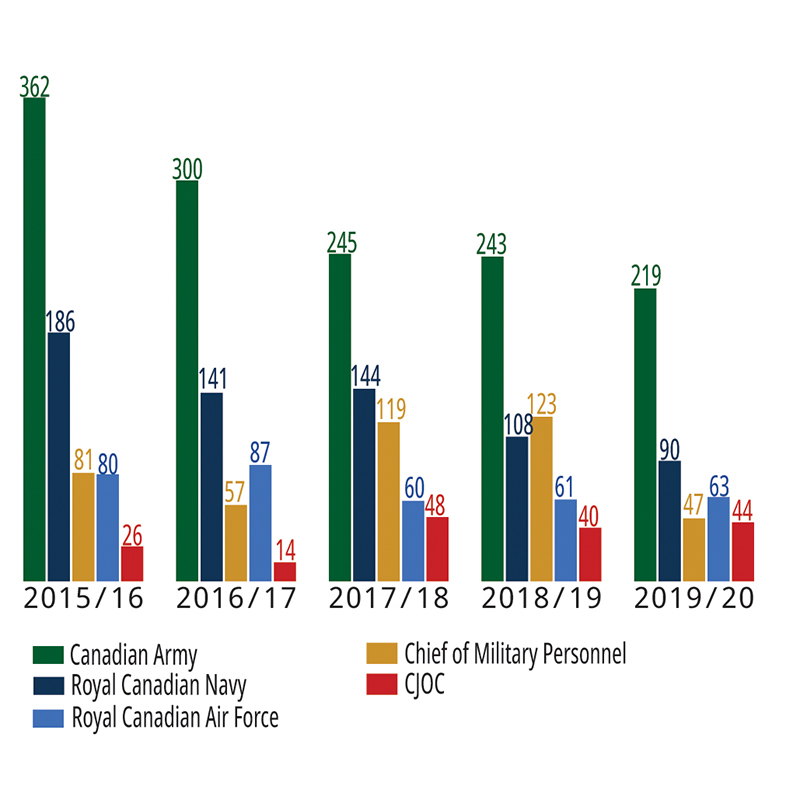
Figure 2-4: Graph breakdown
| 2015/16 | 2016/17 | 2017/18 | 2018/19 | 2019/20 | |
|---|---|---|---|---|---|
| Canadian Army | 362 | 300 | 245 | 243 | 219 |
| Royal Canadian Navy | 186 | 141 | 144 | 108 | 90 |
| Chief of Military Personnel | 81 | 57 | 119 | 123 | 47 |
| Royal Canadian Air Force | 80 | 87 | 60 | 61 | 63 |
| Canada Joint Operations Command | 26 | 14 | 48 | 40 | 44 |
In this reporting period, the Canadian Army held a total of 219 summary trials as opposed to 243 for the previous reporting period. This is a decrease of 24 summary trials (or approximately 10%) from the 2018/19 reporting period. Since 2015/16 the number of summary trials within the Canadian Army has decreased each year.
Since 2015/16 the Royal Canadian Navy has seen a steady decrease in summary trials. During this reporting period, there were a total of 90 summary trials, as compared to 108 in the previous reporting period. This decrease represents a drop of approximately 16%.
The Royal Canadian Air Force conducted 63 summary trials in this reporting period, a slight increase from 61 in the last reporting period. The number of summary trials in the Royal Canadian Air Force has remained relatively consistent over the past three reporting periods.
The most significant change in the number of summary trials in this reporting period came from the Chief of Military Personnel, which had 47 summary trials compared to 123 in the 2018/19 reporting period. This constitutes a decrease of approximately 62% in the number of summary trials for this command.
Finally, the Canadian Joint Operations Command held 44 summary trials during this reporting period, an increase of four summary trials in comparison to the 40 summary trials in the previous reporting period.
Number of Charges Disposed of at Summary Trial
In this reporting period, there were a total of 682 charges disposed of at summary trial compared to 836 charges disposed of at summary trial during the 2018/19 reporting period. Figure 2-5 shows the total number of charges disposed of at summary trial since 2015/16, and demonstrates a consistent decrease.
Figure 2-5: Number of Charges Disposed of at Summary Trial
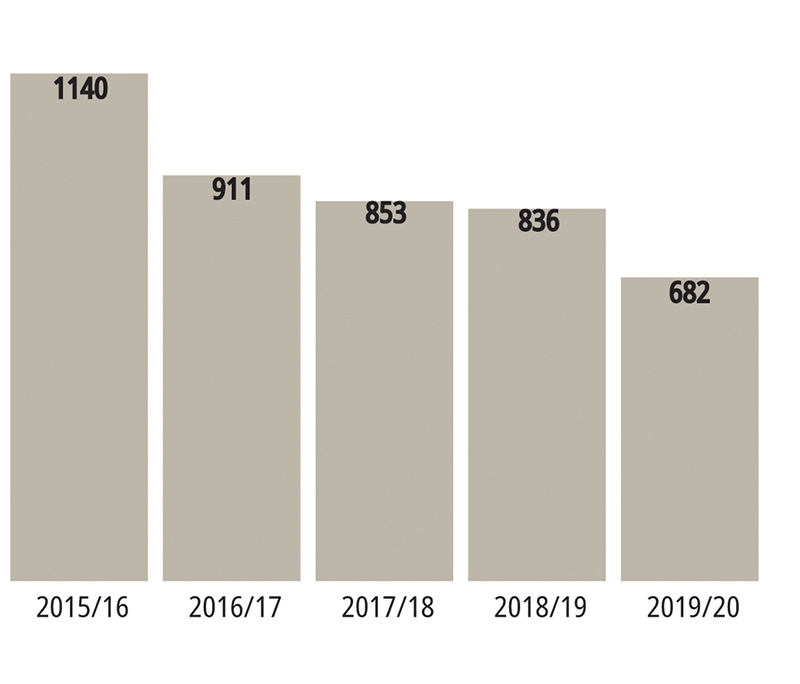
Figure 2-5: Graph breakdown
| 2015/16 | 2016/17 | 2017/18 | 2018/19 | 2019/20 | |
|---|---|---|---|---|---|
| Number of Charges Disposed of at Summary Trial | 1140 | 911 | 853 | 836 | 682 |
The most common types of offences, which account for approximately 73% of all charges disposed of at summary trial, remain absence without leave and conduct to the prejudice of good order and discipline.Footnote 13
Since the 2015/16 reporting period there has been a consistent decline in the total number of charges reported for absence without leave. In the current reporting period the total number was 257, compared to 472 in the 2015/16 reporting period.
In this reporting period there were a total of 240 charges for the offence of conduct to the prejudice of good order and discipline, which is a broad offence category capturing a large variety of conduct within its scope. Although an increase was reported in the 2018/19 reporting period, where the number of charges reached 287, this year the number of charges for conduct to the prejudice of good order and discipline has decreased to 240. This is consistent with the numbers from the 2017/18 reporting period. Figure 2-6 shows the number of charges for absence without leave and conduct to the prejudice of good order and discipline between 2015/16 and 2019/20.
Figure 2-6: Number of Charges for Conduct to the Prejudice of Good Order and Discipline and Absence without Leave
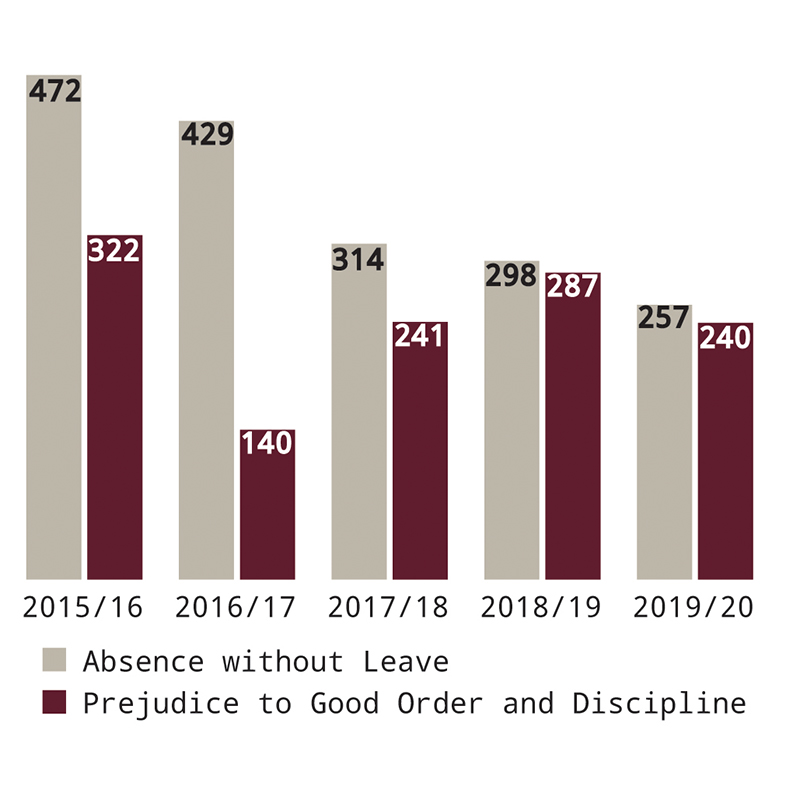
Figure 2-6: Graph breakdown
| 2015/16 | 2016/17 | 2017/18 | 2018/19 | 2019/20 | |
|---|---|---|---|---|---|
| Absence without Leave | 472 | 429 | 314 | 298 | 257 |
| Conduct to the Prejudice of Good Order and Discipline | 322 | 140 | 241 | 287 | 240 |
Number of Elections to be Tried by Court Martial
Pursuant to article 108.17 of the Queen’s Regulations and Orders for the Canadian Forces, in certain circumstances, an accused person has the right to elect to be tried by court martial rather than summary trial. The accused person will not have the opportunity to elect to be tried by court martial if the following criteria apply 1) the accused person has been charged with one of the five “minor” service offences (listed below) and 2) the circumstances surrounding the commission of the offence are sufficiently minor in nature that the officer exercising summary trial jurisdiction over the accused person concludes that a punishment of detention, reduction in rank, or a fine in excess of 25% of the accused person’s monthly basic pay would not be warranted if the accused person were found guilty of the offence.Footnote 14
The five minor offences are: 1) insubordinate behaviour, 2) quarrels and disturbances, 3) absence without leave, 4) drunkenness, and 5) conduct to the prejudice of good order and discipline where the offence relates to military training, maintenance of personal equipment, quarters or workspace, or dress and deportment.
During this reporting period, a total of 144 elections to be tried by court martial were offered to accused persons. Out of the 144 elections offered, 118 accused persons elected to be tried by summary trial, which represents 81.94% of the total elections offered. The remainder of the 26 accused persons elected to be tried by court martial, which represents 18.06% of the total elections offered.
Figure 2-7 represents the percentage of accused persons electing to be tried by court martial, when offered an election, over the past five reporting periods.
Figure 2-8 shows the number of summary trials completed over the past five reporting periods where the accused person was offered an election to be tried by court martial, as well as the number of summary trials completed where no election was offered.
Figure 2-9 shows the number of summary trials completed over the past five reporting periods where the accused person elected to be tried by court martial, expressed as a percentage.
Figure 2-7: Percentage of Accused Electing to be Tried by Court Martial
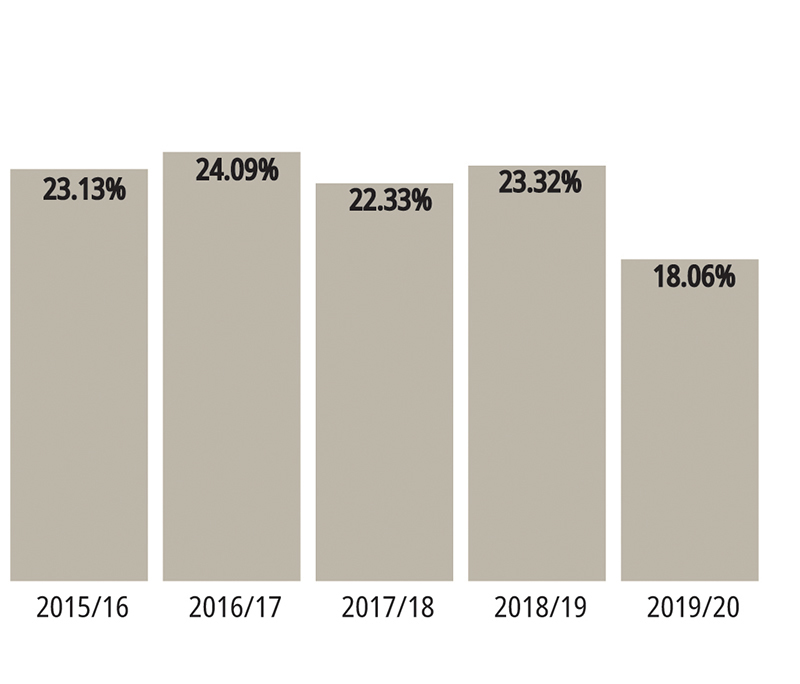
Figure 2-7: Graphis breakdown
| 2015/16 | 2016/17 | 2017/18 | 2018/19 | 2019/20 | |
|---|---|---|---|---|---|
| Percentage of Accused Electing to be Tried by Court Martial | 23.13 | 24.09 | 22.33 | 23.32 | 18.06 |
Figure 2-8: Graphic breakdown
| 2015/16 | 2016/17 | 2017/18 | 2018/19 | 2019/20 | |
|---|---|---|---|---|---|
| Election Not Offered | 527 | 448 |
473 | 426 | 358 |
| Election Offered | 232 | 165 | 163 | 168 | 125 |
| Total | 759 | 613 | 636 | 594 | 483 |
Figure 2-9: Number of Summary Trials Completed where Accused Offered an Election, expressed as a Percentage
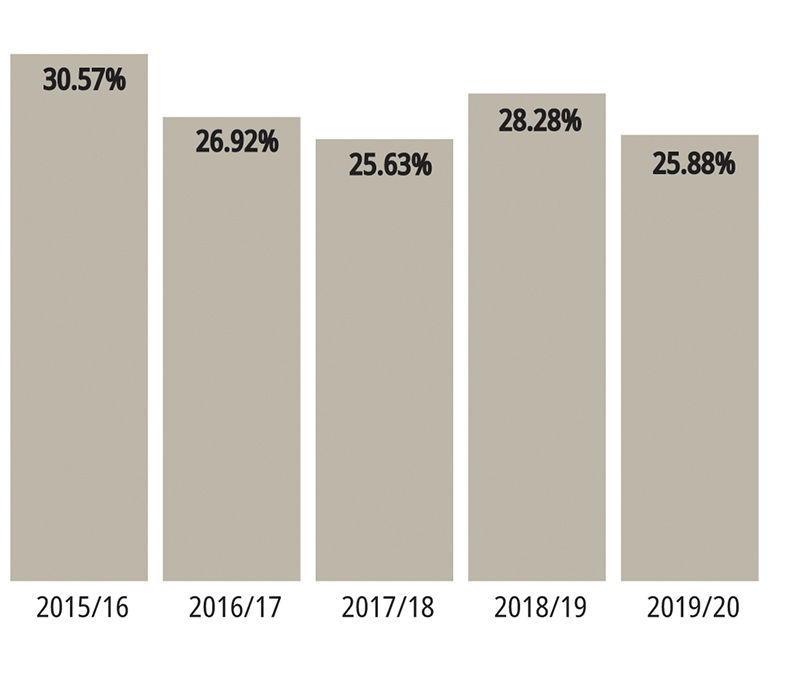
Figure 2-9: Graphic breakdown
| 2015/16 | 2016/17 | 2017/18 | 2018/19 | 2019/20 | |
|---|---|---|---|---|---|
| Number of Summary Trials Completed where Accused Offered an Election, expressed as a Percentage | 30.57 | 26.92 | 25.63 | 28.28 | 25.88 |
Waiver of Limitation Periods
Pursuant to article 108.16 of the Queen’s Regulations and Orders for the Canadian Forces, a charge must be laid against an accused person within six months from the date the service offence is alleged to have been committed and the summary trial must commence within one year of that day. Pursuant to article 108.171 of the Queen’s Regulations and Orders for the Canadian Forces, which came into force on 1 September 2018, an accused person has the right to waive one or both of these limitation periods.Footnote 16
In this reporting period there were 36 waivers offered to accused persons. This represents an increase of nine waivers offered from the 2018/19 reporting period. Of those 36 waivers offered, the accused person chose to waive one or both of the limitation periods in 30 cases.
Results by Charge at Summary Trial
The findings at summary trial, by charge, have remained relatively consistent over the last five reporting periods. For example, the percentage of guilty findings has held steady at approximately 91% and the percentage of non-guilty findings has decreased by 36.36% compared to the previous reporting period. A complete breakdown of the total number of findings by charge and the corresponding percentages for the last two reporting periods can be found at Figure 2-10.
Figure 2-10: Findings by Charge
| 2018-2019 | 2019-2020 | |||
|---|---|---|---|---|
| # | % | # | % | |
| Guilty | 755 | 90.31 | 620 | 90.91 |
| Guilty – Special Finding | 2 | 0.24 | 2 | 0.29 |
| Guilty of related, less serious or attempted offences | 1 | 0.12 | 0 | 0.00 |
| Not guilty | 66 | 7.89 | 42 | 6.16 |
| Charge stayed | 10 | 1.20 | 12 | 1.76 |
| Charge not proceeded with | 2 | 0.24 | 6 | 0.88 |
| Total | 836 | 100 | 682 | 100 |
Punishments and Absolute Discharges at Summary Trial
In this reporting period, there were a total of 609 punishments and absolute discharges at summary trial.Footnote 17 Fines and confinement to ship or barracks continue to be the most commonly imposed punishments. Figure 2-11 shows the total number of punishments and absolute discharges at summary trial for the last two reporting periods as well as the corresponding percent.
Figure 2-11: Punishments and Absolute Discharges at Summary Trial
| 2018-2019 | 2019-2020 | |||
|---|---|---|---|---|
| # | % | # | % | |
| Detention | 11* | 1.51 | 3** | 0.49 |
| Reduction in rank | 3 | 0.41 | 2 | 0.33 |
| Severe reprimand | 4 | 0.55 | 2 | 0.33 |
| Reprimand | 21 | 2.88 | 23 | 3.78 |
| Fine | 432 | 59.26 | 377 | 61.90 |
| Confinement to ship or barracks | 184 | 25.24 | 143 | 23.48 |
| Extra work and drill | 44 | 6.04 | 52 | 8.54 |
| Stoppage of leave | 11 | 1.51 | 6 | 0.99 |
| CautionFootnote 18 | 6 | 0.82 | 0 | 0.00 |
| Absolute DischargeFootnote 19 | 13 | 1.78 | 1 | 0.16 |
| Total | 729 | 100 | 609 | 100 |
| * Includes one punishment which was a Suspended Detention ** Includes one punishment which was a Suspended Detention |
||||
In this reporting period, the punishment of detention was imposed three times. This represents a decrease of approximately 73% from the previous reporting period where 11 punishments of detention were imposed. An overview of the number of times the punishment of detention was imposed at summary trial over the last five reporting periods can be found in Figure 2-12.
Figure 2-12: Total Punishments of Detention
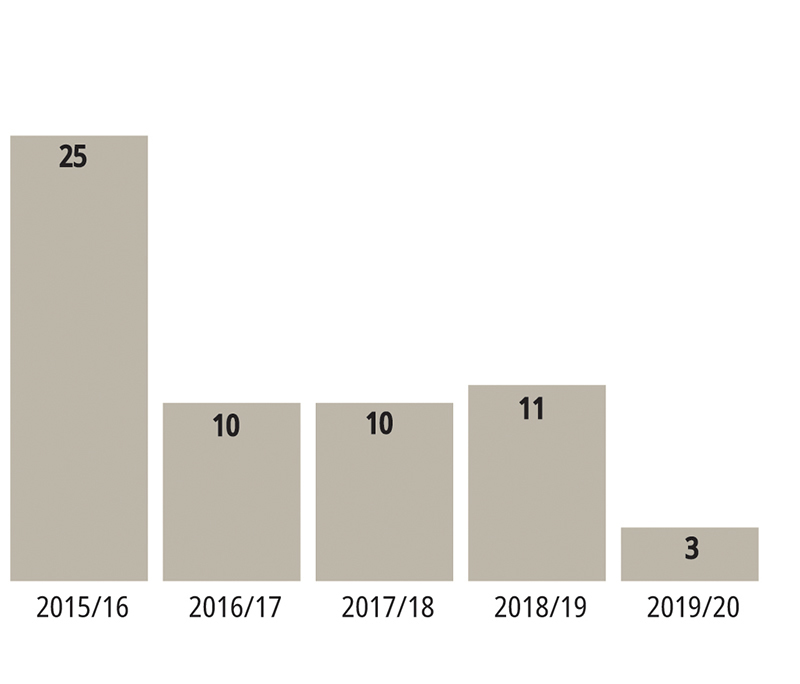
Figure 2-12: Graph breakdown
| 2015/16 | 2016/17 | 2017/18 | 2018/19 | 2019/20 | |
|---|---|---|---|---|---|
| Total Punishments of Detention | 25 | 10 | 10 | 11 | 3 |
Summary Trial Reviews
In the current reporting period, a total of 28 summary trials were reviewed based on requests by members found guilty at summary trial or on a review authority’s own initiative, pursuant to articles 108.45 and 116.02 of the Queen’s Regulations and Orders for the Canadian Forces. Of a total of 483 summary trials, 5.8% of cases were reviewed. This is a slight increase from the previous reporting period, when 5.38% of cases were reviewed. Of those reviews, eight were based on findings, 14 were based on sentences, and six were based on both findings and sentences. Figure 2-13 shows the percentage of cases for which a review has been conducted since 2015/16.
Figure 2-13: Percentage of Summary Trials Reviewed
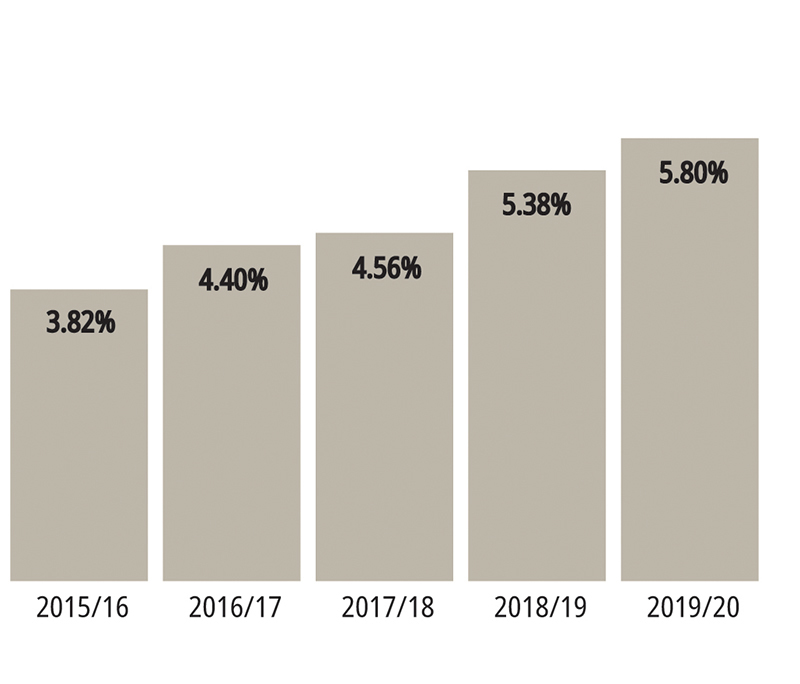
Figure 2-13: Graph breakdown
| 2015/16 | 2016/17 | 2017/18 | 2018/19 | 2019/20 | |
|---|---|---|---|---|---|
| Percentage of Summary Trials Reviewed | 3.82 | 4.40 | 4.56 | 5.38 | 5.80 |
Based on the nature of the request for review, the review authority has several options available to them in rendering a decision. A review authority might uphold the decision of the presiding officer, quash a finding of guilt, or substitute a finding or punishment. In 42.42% of decisions, the review authority quashed the decision of the presiding officer. In 27.27% of decisions, the review authority upheld the decision of the presiding officer. A complete breakdown of all decisions of a review authority for the past two reporting periods can be found at Figure 2-14.
Figure 2-14: Decisions of Review Authority
| 2018-2019 | 2019-2020 | |||
|---|---|---|---|---|
| # | % | # | % | |
| Upholds decision | 11 | 29.73 | 9 | 27.28 |
| Quashes findings | 11 | 29.73 | 14 | 42.42 |
| Substitutes findings | 1 | 2.70 | 1 | 3.03 |
| Substitutes punishment | 6 | 16.22 | 3 | 9.09 |
| Mitigates / commutes / remits punishment | 8 | 21.62 | 6 | 18.18 |
| Total | 37Footnote 20 | 100 | 33Footnote 21 | 100 |
Harmful and Inappropriate Sexual Behaviour and Sexual Misconduct
At the summary trial level, harmful and inappropriate sexual behaviour and sexual misconduct are most frequently charged under section 129 of the National Defence Act, conduct to the prejudice of good order and discipline. In the current reporting period there were a total of 30 charges for harmful and inappropriate sexual behaviour and sexual misconduct, compared to 45 charges in the previous reporting period.
Of the 30 charges of this nature during this reporting period, there were 28 findings of guilt and two findings of not guilty. In the previous reporting period, there were 37 findings of guilt, six findings of not guilty, and two charges which were stayed.
Language of Summary Trials
Pursuant to article 108.16 of the Queen’s Regulations and Orders for the Canadian Forces, an accused member has the right to be tried in the official language of their choice. The presiding officer must be able to understand the language in which the proceedings are to be conducted without the assistance of an interpreter.
In this reporting period, approximately 77% of summary trials were conducted in English and approximately 23% were conducted in French. This shows a slight decrease in summary trials conducted in English and a slight increase in summary trials conducted in French, when compared to previous reporting periods. Figure 2-15 shows the total number of summary trials conducted in both English and French for the past two reporting periods.
Figure 2-15: Language of Summary Trials
| 2018-2019 | 2019-2020 | |||
|---|---|---|---|---|
| # | % | # | % | |
| Number in English | 479 | 80.64 | 373 | 77.23 |
| Number in French | 115 | 19.36 | 110 | 22.77 |
| Total | 594 | 100 | 483 | 100 |
Timelines for Summary Trials
The purpose of the summary trial system is to provide prompt but fair justice in respect of minor service offences. As such, these trials are required to begin within one year of the date on which the offence is alleged to have occurred, unless this limitation period is waived by the accused person.Footnote 22
This reporting period saw 483 summary trials, and the average time from the alleged offence to the conclusion of the summary trial was approximately 108 days. Of those 483 summary trials, 280 were concluded within 90 days of the alleged offence, representing approximately 58% of all summary trials for the reporting period. Further, 82.6% of all summary trials were concluded within 180 days of the alleged offence. Figure 2-16 shows a breakdown of the number of days from the alleged offence to the conclusion of the summary trial.
Figure 2-16: Number of Days from Alleged Offence to Conclusion of the Summary Trial for Reporting Period 2019/20Footnote 23
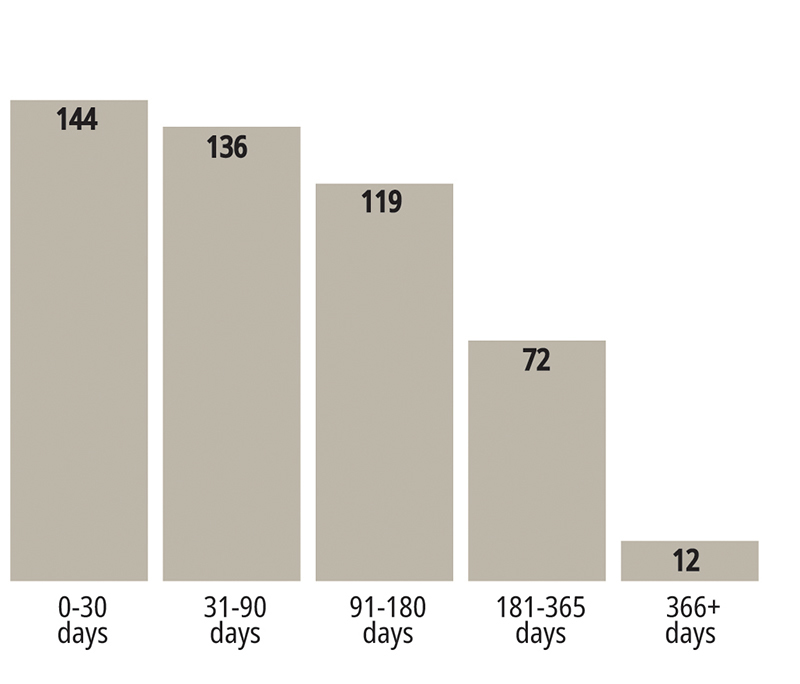
Figure 2-16: Graph breakdown
| 0-30 days | 31-90 days | 91-180 days | 181-365 days | 366 days or more | |
|---|---|---|---|---|---|
| Number of Days from Alleged Offence to the Conclusion of the Summary Trial for Reporting Period 2019/20 | 144 | 136 | 119 | 72 | 12 |
Once a charge has been laid by the appropriate authority and is referred to a presiding officer, the presiding officer may be required to obtain legal advice before commencing the summary trial.Footnote 24 Once that advice has been received from the unit legal adviser, the presiding officer may commence the summary trial. Current reporting capabilities do not provide data on the length of summary trials, however with the continued development of the Justice Administration and Information Management System, this data will be available to the Office of the JAG in future reporting periods.
Over the past five reporting periods, the average number of days between the time a charge is laid to the conclusion of the summary trial has fluctuated, reaching a low of 15 days in the 2017/18 reporting period. During the current reporting period, this number has increased to approximately 25 days. Figure 2-17 shows the average number of days from charge laid to the conclusion of the summary trial over the last five reporting periods.
Figure 2-17: Average Number of Days from Charge Laid to Summary Trial
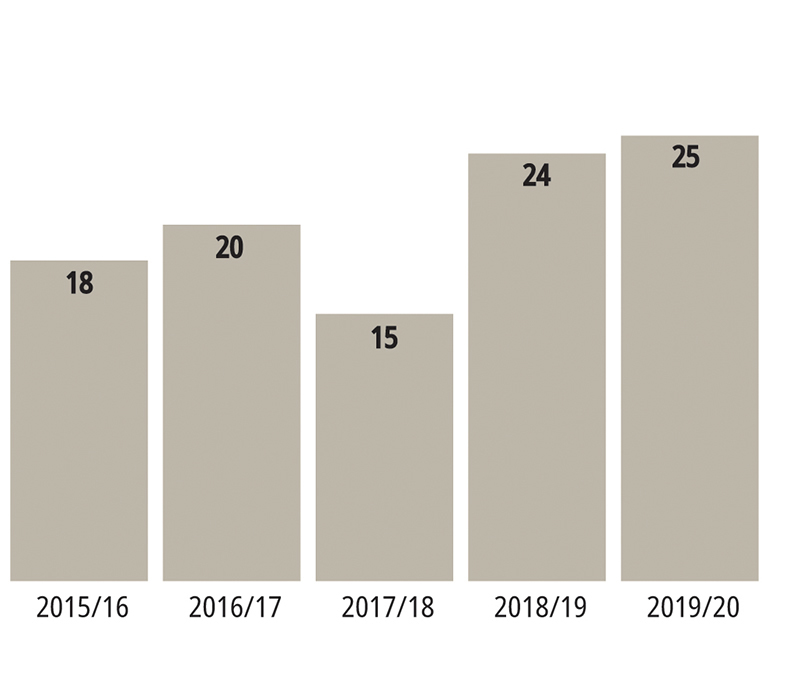
Figure 2-17: Graph breakdown
| 2015/16 | 2016/17 | 2017/18 | 2018/19 | 2019/20 | |
|---|---|---|---|---|---|
| Average Number of Days from Charge Laid to Summary Trial |
18 | 20 | 15 | 24 | 25 |
Courts Martial
Number of Courts Martial
During this reporting period, there were a total of 55 courts martial, representing approximately 10% of all trials held before service tribunals. This is a slight increase from the previous reporting period. Figure 2-18 demonstrates the number of courts martial by year since 2015/16.
Figure 2-18: Number of Courts Martial
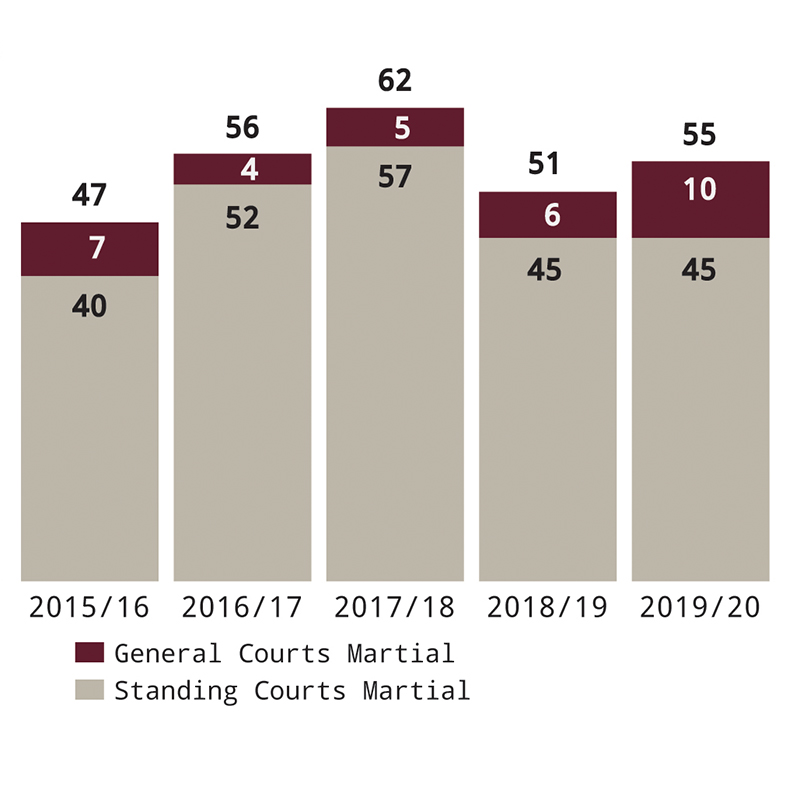
Figure 2-18: Graph breakdown
| 2015/16 | 2016/17 | 2017/18 | 2018/19 | 2019/20 | |
|---|---|---|---|---|---|
| General Courts Martial | 7 | 4 | 5 | 6 | 10 |
| Standing Courts Martial | 40 | 52 | 57 | 45 | 45 |
| Total | 47 | 56 | 62 | 51 | 55 |
Results by Case at Court Martial
Of the 55 courts martial held this reporting period, 44 cases resulted in a finding of guilt on at least one charge and seven cases resulted in a finding of not guilty on all charges. Figure 2-19 shows disposition by case over the past two reporting periods.
Figure 2-19: Disposition of Cases at Court Martial
| 2018-2019 | 2019-2020 | |||
|---|---|---|---|---|
| # | % | # | % | |
| Found Guilty of at Least One Charge | 43 | 84.31 | 44 | 80.00 |
| Not Guilty of All Charges | 6 | 11.77 | 7 | 12.73 |
| Stay of All Charges | 0 | 0.00 | 0 | 0.00 |
| Withdrawal of All Charges | 1 | 1.96 | 3 | 5.45 |
| Termination of Proceedings | 1 | 1.96 | 1 | 1.82 |
| Total | 51 | 100 | 55 | 100 |
Director of Military Prosecutions Case Management
Referrals
During this reporting period, the Directorate of Military Prosecutions received a total of 76 referrals as compared to 102 in the previous reporting period, a decline of 25.5%. There were also 54 cases carried over from the previous reporting period resulting in a total of 130 referrals processed in 2019/20 as compared to 172 in 2018/19, a decrease of 24.42%. Of these 130 cases, post-charge decisions were made by the Canadian Military Prosecution Service in 87 cases, with the remainder carried over to the next reporting period.
Figure 2-20 shows the number of referrals received from the Director of Military Prosecutions over the last five reporting periods with a comparison as to how many were processed within each respective reporting period.
Figure 2-20: Number of Referrals
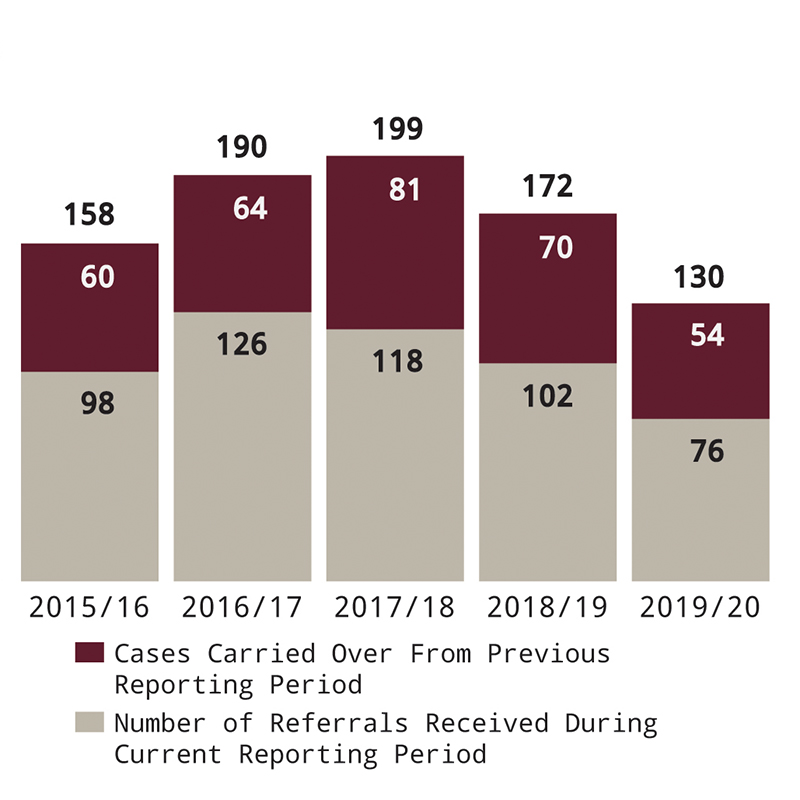
Figure 2-20: Graph breakdown
| 2015/16 | 2016/17 | 2017/18 | 2018/19 | 2019/20 | |
|---|---|---|---|---|---|
| Cases Carried Over From Previous Reporting Period | 60 | 64 | 81 | 70 | 54 |
| Number of Referrals Received During Current Reporting Period | 98 | 126 | 118 | 102 | 76 |
| Total | 158 | 190 | 199 | 172 | 130 |
Preferrals and Non-PreferralsFootnote 26
During this reporting period, there were 56 cases preferred for trial by court martial and 31 cases in which no charges were preferred. The percentage of cases preferred for trial by court martial for this reporting period was 64.37%. This number represents a slight decrease from the 2018/19 reporting period in which 107 cases were preferred, or 69%. In the past five reporting periods, the highest rate of preferrals was 69% in the previous reporting period and the lowest rate of preferrals was 57% in the 2017/18 reporting period.
Figure 2-21 illustrates the number of files preferred by the Director of Military Prosecutions and the number of files where no charges were preferred over the past five reporting periods.
Figure 2-21: Number of Preferrals and Non-Preferrals
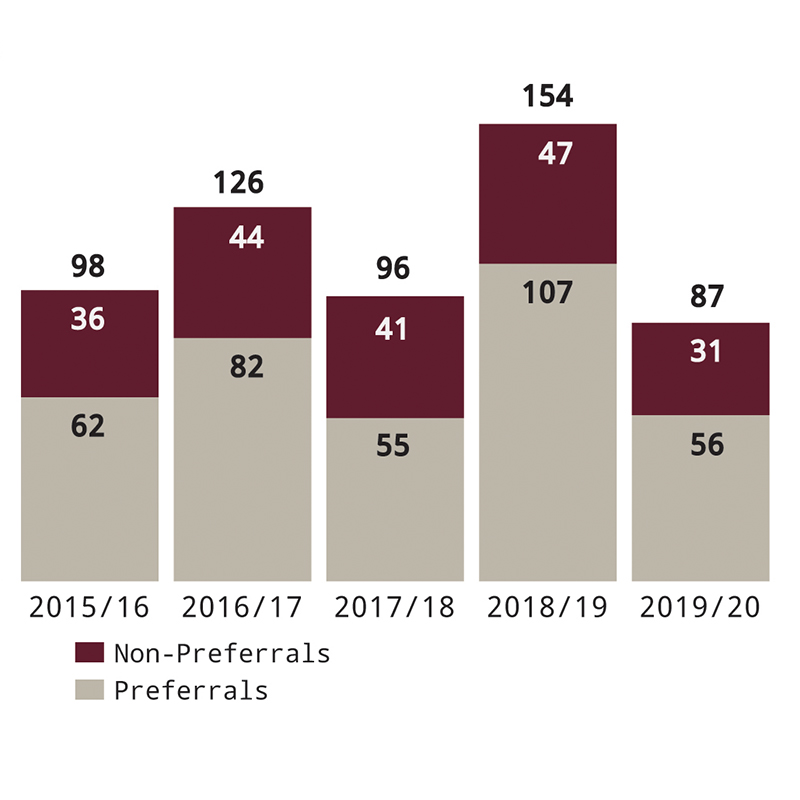
Figure 2-21: Graph breakdown
| 2015/16 | 2016/17 | 2017/18 | 2018/19 | 2019/20 | |
|---|---|---|---|---|---|
| Non-Preferrals | 36 |
44 | 41 | 47 | 31 |
| Preferrals | 62 |
82 | 55 | 107 | 56 |
| Total | 98 |
126 | 96 | 154 | 87 |
Timelines
During this reporting period, the average number of days from referral of a matter to the Director of Military Prosecutions until a post-charge decision was approximately 70 days, a decrease of approximately 18 days, or 20.45% from the previous reporting period. Figure 2-22 illustrates the average number of days from referral to post-charge decision over the course of the past five reporting periods.
Figure 2-22: Number of Days from Referral of File to the Director of Military Prosecutions to Post-Charge Decision
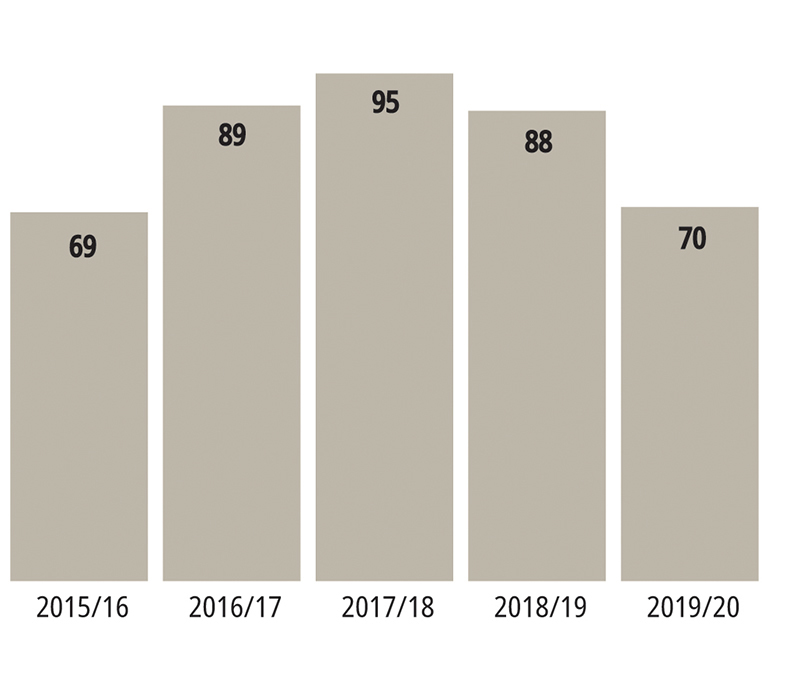
Figure 2-22: Graph breakdown
| 2015/16 | 2016/17 | 2017/18 | 2018/19 | 2019/20 |
|---|---|---|---|---|
| 69 | 89 | 95 | 88 | 70 |
During this reporting period, the average length of time it took for the commencement of a court martial following the preferral of charges was 278 days, an increase from the previous reporting period by 34 days, or 13.93%. The average number of days from the preferral of a charge to the commencement of a court martial in the previous reporting period was 244 days. Figure 2-23 demonstrates, over the past five reporting periods, the average length of time for a court martial to commence once charges against an accused person were preferred.
Figure 2-23: Number of Days from Preferral of Charges to Beginning of Court Martial
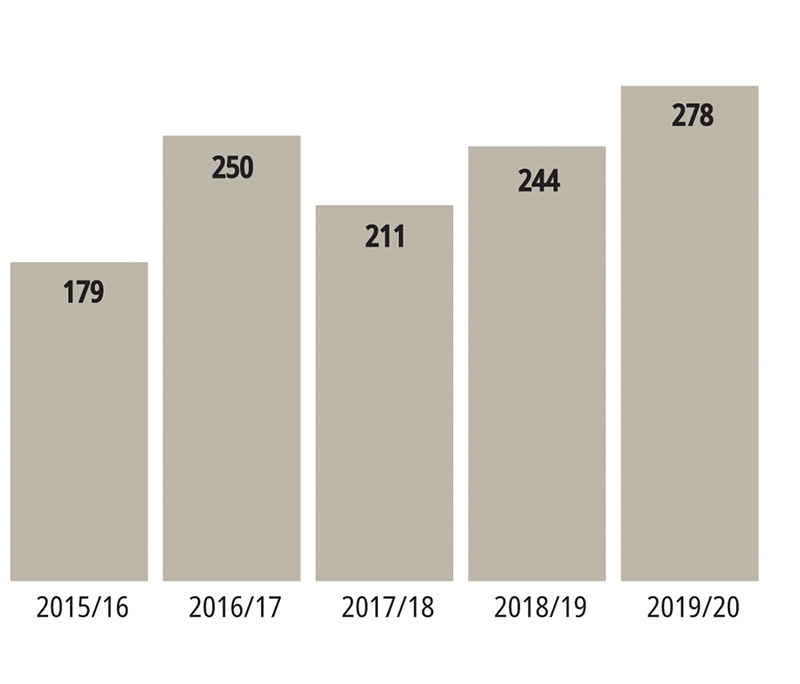
Figure 2-23: Long description
| 2015/16 | 2016/17 | 2017/18 | 2018/19 | 2019/20 |
|---|---|---|---|---|
| 179 | 250 | 211 | 244 | 278 |
Punishments at Court Martial
In the 2019/20 reporting period, 42 sentences were pronounced by courts martial, involving a total of 63 punishments. The most common punishments imposed continue to be fines (32 in total), representing 51% of punishments, followed by 15 severe reprimands (24% of punishments). A total of three custodial punishments, representing approximately 5% of punishments, were imposed by courts martial, including two imprisonments and one detention. Figure 2-24 breaks down the punishments imposed by courts martial over the past two reporting periods.
Figure 2-24: Punishments at Courts Martial
| 2018-2019 | 2019-2020 | |
|---|---|---|
| Dismissal | 2 | 1 |
| Imprisonment | 3 | 2** |
| Detention | 1* | 1*** |
| Reduction in Rank | 2 | 3 |
| Forfeiture of Seniority |
0 | 1 |
| Severe Reprimand | 10 | 15 |
| Reprimand | 4 | 6 |
| Fine | 35 | 32 |
| Confinement to ship or barracks | 0 | 0 |
| Stoppage of leave | 0 | 0 |
| Absolute Discharge |
0 | 2 |
| Total | 57 | 63 |
| * This punishment was suspended by the Military Judge. ** One of these punishments was suspended by the Military Judge. *** This punishment was suspended by the Military Judge. |
||
Sexual Misconduct
A total of 25 courts martial dealing with sexual misconduct charges were completed during this reporting period. Of those, 18 cases resulted in a finding of guilt on at least one charge, five cases resulted in a finding of not guilty, one case resulted in a stay of proceedings, and in one case all charges were withdrawn by the Director of Military Prosecutions. In the 2018/19 reporting period a total of 20 courts martial dealt with charges of sexual misconduct, with 14 of those resulting in a guilty finding. This reporting period saw an increase of 25% in the number of courts martial dealing with sexual misconduct and an increase of approximately 29% in the number of guilty findings.
